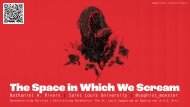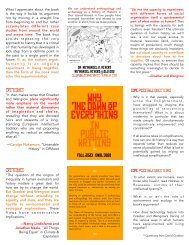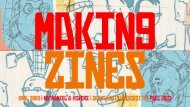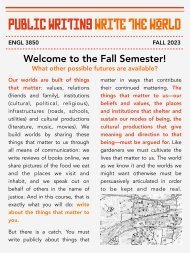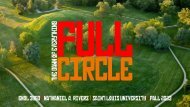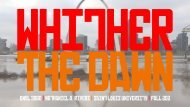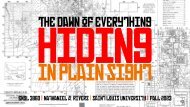You also want an ePaper? Increase the reach of your titles
YUMPU automatically turns print PDFs into web optimized ePapers that Google loves.
<strong>Carrier</strong> bags<br />
AS WEAK THEORY<br />
Stewart and Le Guin
In The <strong>Carrier</strong> Bag <strong>Theory</strong> of Fiction, visionary author Ursula K. Le Guin<br />
retells the story of human origin by redefining technology <strong>as</strong> a cultural<br />
carrier bag rather than a weapon of domination.<br />
Hacking the linear, progressive mode of the Techno-Heroic, the <strong>Carrier</strong><br />
Bag <strong>Theory</strong> of human evolution proposes: “before the tool that forces<br />
energy outward, we made the tool that brings energy home.” Prior to the<br />
preeminence of sticks, swords and the Hero’s long, hard, killing tools,<br />
our ancestors’ greatest invention w<strong>as</strong> the container: the b<strong>as</strong>ket of wild<br />
oats, the medicine bundle, the net made of your own hair, the home, the<br />
shrine, the place that contains whatever is sacred. The recipient, the<br />
holder, the story. The bag of stars.<br />
This influential essay opens a portal to terra ignota: unknown lands<br />
where the possibilities of human experience and knowledge can be<br />
discovered anew.
Le Guin<br />
Not just the bottle of gin or wine, but the bottle in its older<br />
sense of container in general, a thing that holds<br />
something else (150).
The Vuvalini, the Many<br />
Mothers, and their<br />
longing for shows,<br />
for stories.<br />
“Shows. Everyone in the<br />
old world had a show.”<br />
These shows are<br />
thought <strong>as</strong> linkages<br />
to others that might<br />
still be out there.<br />
“Do you think there’s still<br />
somebody out there?<br />
Sending shows?<br />
Mad Max: Fury Road, 2015
Where is that wonderful, big, long, hard thing, a bone, I believe,<br />
that the Ape Man first b<strong>as</strong>hed somebody with in the movie and<br />
Le Guin<br />
then, grunting with ecst<strong>as</strong>y at having achieved the first proper<br />
murder, flung up into the sky, and whirling there it became a<br />
space ship thrusting its way into the cosmos to fertilize it<br />
and produce at the end of the movie a lovely fetus, a boy of<br />
course, drifting in the Milky Way without (oddly enough) any<br />
womb, any matrix at all? I don’t know. I don’t even care. I’m<br />
not telling that story (150-51).
The linkage, the<br />
chain, b e t w e e n<br />
discovery/invention,<br />
violence, exploration<br />
and the human here<br />
is rather striking.<br />
This linkage is not<br />
without merit, but it is<br />
certainly in need of a<br />
complication.<br />
2001: A Space Odyssey, 1968
2001: A Space Odyssey, 1968<br />
I don’t know. I don’t<br />
even care. I’m not<br />
telling that story.
[B]ut how do you get more than one stomachful and one<br />
Le Guin<br />
handful home? [...] A holder. A recipient.<br />
The first cultural device w<strong>as</strong> probably a recipient...Many theorizers feel<br />
that the earliest cultural inventions must have been a container to<br />
hold gathered products and some kind of sling or net carrier.<br />
So says Elizabeth Fisher in Women’s Creation. But no, this<br />
cannot be. (150)
The team found psychoactive compounds in an<br />
animal-skin pouch constructed of three fox snouts<br />
stitched together, Jose Capriles, Penn State, 2019.
Le Guin<br />
[L]ong before the useful knife and ax; right along with the<br />
indispensable whacker, grinder, and digger—[...]—with or<br />
before the tool that forces energy outward, we made the tool<br />
that brings energy home. It makes sense to me. (151)
Le Guin<br />
So long <strong>as</strong> culture w<strong>as</strong> explained <strong>as</strong> originating from and<br />
elaborating upon the use of long, hard objects for sticking,<br />
b<strong>as</strong>hing, and killing, I never thought that I had, or wanted,<br />
any particular share in it. (151)
Le Guin<br />
So the Hero h<strong>as</strong> decreed through his mouthpieces the<br />
Lawgivers, first, that the proper shape of the narrative is that<br />
of the arrow or spear, starting here and going straight there<br />
and THOK! hitting its mark (which drops dead); second, that<br />
the central concern of the narrative, including the novel, is<br />
conflict; and third, the story isn’t any good if he isn’t in it. (153-54)
Russell Brandom maps an action sequence in Skyfall for The Verge.
Le Guin<br />
I differ with all of this. I would go so far <strong>as</strong> to say that the natural,<br />
proper, fitting shape of the novel might be that of a sack, a<br />
bag. A book holds words. Words hold things. They bear<br />
meanings. A novel is a medicine bundle, holding things in a<br />
particular, powerful relation to one another and to us. (153)
Russell Brandom maps an action sequence in Mad Max for The Verge.
Le Guin<br />
It is a strange realism, but it is a strange reality. (154)
“Breaking down the chaos of a Mad Max car ch<strong>as</strong>e.” Russell Brandom, The Verge
Just prior to this, The<br />
Dag, one of Immortan<br />
Joe’s wives, w<strong>as</strong><br />
<strong>as</strong>king The Keeper of<br />
the Seeds about the<br />
latter’s proficiency with<br />
a rifle.<br />
This scene is thus in<br />
pointed contradistinction<br />
to the gun<br />
scene.<br />
In an earlier scene,<br />
bullets are referred to<br />
<strong>as</strong> “anti-seeds”: “plant<br />
one and watch the<br />
thing die.”<br />
Mad Max: Fury Road, 2015
Le Guin<br />
Still there are seeds to be gathered, and<br />
room in the bag of stars (154).
Ordinary Affects is a singular argument for attention to the affective<br />
dimensions of everyday life and the potential that animates the ordinary.<br />
Known for her focus on the poetics and politics of language and<br />
landscape, the anthropologist Kathleen Stewart ponders how ordinary<br />
impacts create the subject <strong>as</strong> a capacity to affect and be affected. In a<br />
series of brief vignettes combining storytelling, close ethnographic detail,<br />
and critical analysis, Stewart relates the intensities and banalities of<br />
common experiences and strange encounters, half-spied scenes and<br />
the lingering resonance of p<strong>as</strong>sing events. While most of the instances<br />
rendered are from Stewart’s own life, she writes in the third person in<br />
order to reflect on how intimate experiences of emotion, the body, other<br />
people, and time inextricably link us to the outside world.
Stewart<br />
It’s a mode of production through which something that<br />
feels like something throws itself together. An opening<br />
onto a something, it maps a thicket of connections<br />
between vague yet forceful and affecting elements (72).
The Breakf<strong>as</strong>t Club, 1985
Stewart<br />
To inhabit a space of attending to things is to incite<br />
attention to co-existing forms of composition,<br />
habituation, performance, and event and to the “weak”<br />
ontologies of lived collective fictions comprised of<br />
diacritical relations, differences, affinities, affects, and<br />
trajectories (73).
Stewart<br />
For me, then, the point of theory now is not to judge the<br />
value of analytic objects or to somehow get their<br />
representation “right” but to wonder where they might<br />
go and what potential modes of knowing, relating, and<br />
attending to things are already somehow present in<br />
them <strong>as</strong> potential or resonance (73).
Stewart<br />
Tracing the worlds that people make out of requires a<br />
supple attention and the capacity to imagine<br />
trajectories and follow tendencies into scenes of their<br />
excess or end points (78).
Stewart<br />
Matter in an unfinished world is itself indefinite—a not<br />
yet that fringes every determinate context or<br />
normativity with a margin of something deferred or<br />
something that failed to arrive, or h<strong>as</strong> been lost, or is<br />
waiting in the wings, n<strong>as</strong>cent, perhaps pressing (80).
Veg<strong>as</strong>, of course, is a different story with different trajectories to<br />
Stewart<br />
trace. And so is the story of the m<strong>as</strong>ter-planned, and the story of the<br />
homeless, and countless other stories that can be told. But they all<br />
have their forms of alertness to the poesis of a something snapping<br />
into place, if only for a minute. All of these stories of tracing things<br />
that come together have their attachments to potentiality and<br />
their constant production of the sense of being in something—<br />
something grand, something degraded, something dumb—whatever.<br />
Everywhere now you hear the question “how’d you get into that?”<br />
Things don’t just add up.
Stewart<br />
The moment when things throw themselves together<br />
into something that feels like something is the kind of<br />
cultural production that's often given form in literature and<br />
poetry and folklore (76).
The look and feel of<br />
Unknown Fields’ projects<br />
and productions resonates<br />
with Le Guin, and they<br />
point toward what a<br />
“<strong>Carrier</strong> Bag <strong>Theory</strong> of<br />
Reports” might be.<br />
“Here we are both<br />
visionaries and reporters,<br />
part documentarians and<br />
part science fiction<br />
soothsayers <strong>as</strong> the<br />
otherworldly sites we<br />
encounter afford us a<br />
distanced viewpoint from<br />
which to survey the<br />
consequences of emerging<br />
environmental and<br />
technological scenarios."<br />
Unknown Fields, Division Showreel, 2013
Images from Unknown Fields’ Tales from the Dark Side of the City, Perimeter, 2016.
Images from Emergence Magazine.
<strong>Carrier</strong> bags<br />
AS WEAK THEORY<br />
Stewart and Le Guin




